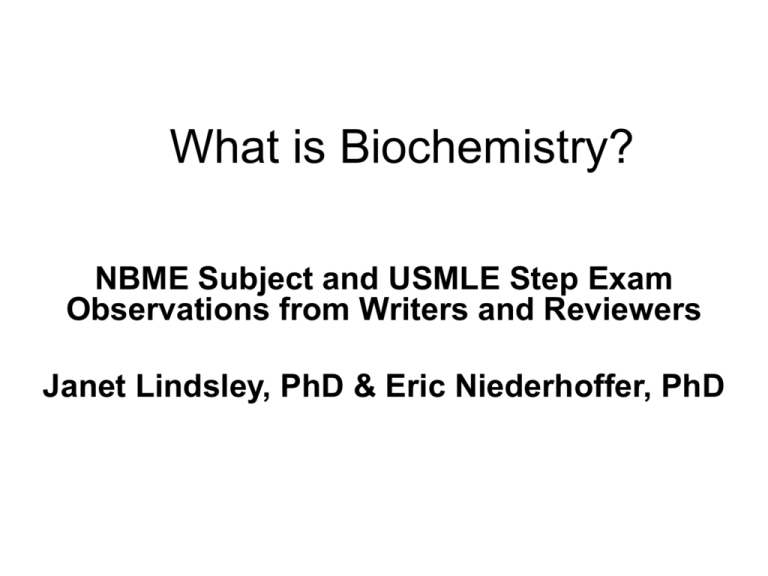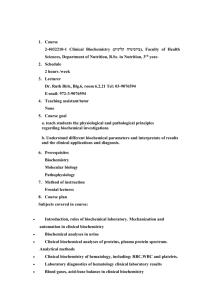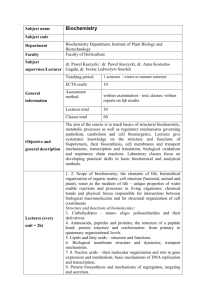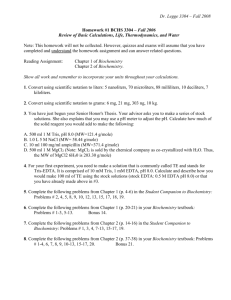pptx - SIU School of Medicine
advertisement

What is Biochemistry? NBME Subject and USMLE Step Exam Observations from Writers and Reviewers Janet Lindsley, PhD & Eric Niederhoffer, PhD Discussion outline • Introduction to the NBME & USMLE • Roles of Test Development and Interdisciplinary Review Committees • Unofficial opinions regarding Biochemistry Subject exam questions and Step 1 questions • Would you call this BIOCHEMISTRY? National Board of Medical Examiners (NBME) Mission and Vision • To protect the health of the public through state of the art assessment of health professionals. While centered on assessment of physicians, this mission encompasses the spectrum of health professionals along the continuum of education, training and practice and includes research in evaluation as well as development of assessment instruments. • Improving healthcare around the world through assessment http://www.nbme.org/about/ Subject & Shelf Exams • Basic science Behavioral sciences, Biochemistry, Gross anatomy only (Gross anatomy + Embryology, Gross anatomy + Embryology + Human developmental biology), Histology and cell biology, Microbiology only (Microbiology + Immunology), Neuroscience, Pathology, Pharmacology, Physiology • Clinical science • Advanced clinical examinations • Comprehensive examinations http://www.nbme.org/PDF/SubjectExams/subexaminfoguide.pdf United States Medical Licensing Examination (USMLE) • Step 1 – assesses understanding and application of important concepts of the sciences basic to the practice of medicine, with special emphasis on principles and mechanisms underlying health, disease, and modes of therapy • Step 2 CK – assesses application of medical knowledge, skills, and understanding of clinical science essential for the provision of patient care under supervision and includes emphasis on health promotion and disease prevention • Step 2 CS – uses standardized patients to test medical students and graduates on their ability to gather information from patients, perform physical examinations, and communicate their findings to patients and colleagues • Step 3 – assesses application of medical knowledge and understanding of biomedical and clinical science essential for the unsupervised practice of medicine, with emphasis on patient management in ambulatory settings http://www.usmle.org USMLE Step 1 Test Specifications http://www.usmle.org/step-1/#content-outlines USMLE Step 1 Test Specifications http://www.usmle.org/step-1/#content-outlines Expanded new USMLE content outline (available as of April 2015) For example: Planned changes for USMLE Step 1 http://www.usmle.org/ Changes_to_USMLE_handout.pdf 2015-2016 Test Material Development Committees (TMDCs) TMDC Behavioral health Biostatistics and epidemiology Evidence based medicine Gross anatomy and embryology Microbiology and immunology Neurology and neuroscience Pathology and genetics Pharmacology and biochemistry Physiology and cell biology http://www.nbme.org/PDF/Publications/2014Annual-Report.pdf Interdisciplinary Review Committees (IRCs) IRC Cross Step Step 1 Step 2 CK Step 2 CS Step 3 Computer-based case simulations Step 3 Roles: • Review all questions (including pre-tested items) before going on an exam, and then on regular 3-year intervals while they are active questions, for content accuracy. • Remove “buzz” words (eg, blue sclerae, ragged red fibers). • Check tagging of questions for accuracy. • Determine for which Step or Subject exams each question is most appropriate. http://www.nbme.org/PDF/Publications/2014Annual-Report.pdf Comparison of Subject and Step 1 Questions Subject test questions Step 1 test questions More detailed biochemistry More focus on overview concepts and reasoning More likely to look like traditional biochemistry More likely that a biochemist who has never taught “medical biochemistry” would not even recognize the question More likely to avoid content knowledge of other disciplines Biochemistry more integrated with other foundational and clinical sciences Less use of images and schemes More use images, pathway schemes, and tables of data Comparison of Subject and Step Questions Native collagen is composed almost entirely of which of the following types of structures? (A) α-Helix (B) β-Pleated sheet (C) Random coils (D) Triple helix (E) Two peptides connected by a disulfide bond SE_ContentOutlineandSampleItems.pdf Comparison of Subject and Step Questions Which of the following is required to transport fatty acids across the inner mitochondrial membrane? (A) Acyl carrier protein (B) Albumin (C) Carnitine (D) Chylomicrons (E) Creatinine (F) Lecithin-cholesterol acyltransferase SE_ContentOutlineandSampleItems.pdf Comparison of Subject and Step Questions A 67-year-old man has a restricted diet that includes no fresh citrus fruits or leafy green vegetables. His teeth are loose and his gums bleed easily. This patient’s disorder most likely results from a defect in collagen synthesis that involves which of the following amino acids? (A) Arginine (B) Cysteine (C) Histidine (D) Hydroxyproline (E) Leucine (F) Methionine (G) Serine (H) Tryptophan SE_ContentOutlineandSampleItems.pdf Comparison of Subject and Step Questions A 14-year-old girl is brought to the physician because of a recent growth spurt of 15 cm (6 in) during the past year. She also has had increasing fatigue and palpitations during this period. Her paternal aunt has a history of palpitations and severe myopia. She is at the 95th percentile for height and 50th percentile for weight. Physical examination shows a long, thin face. Ophthalmologic examination shows dislocated lenses. Cardiac examination shows a hyperdynamic precordium with early click and systolic murmur. Echocardiography shows an enlarged aortic root and mitral valve prolapse. Abnormal synthesis of which of the following proteins is the most likely cause of this patient’s disorder? (A) Collagen, type I (B) Elastin (C) Fibrillin-1 (D) Fibroblast growth factor R3 (E) Laminin (F) Neurofibromin (G) PAX 6 SE_ContentOutlineandSampleItems.pdf Comparison of Subject and Step Questions A 2-year-old boy with mental retardation has chewed the tips of his fingers on both hands and a portion of his lower lip. His serum uric acid concentration is increased, and he has a history of uric acid renal calculi. His 5-year-old brother has similar findings. Which of the following abnormal enzyme activities is the most likely cause of these findings? (A) Decreased adenine phosphoribosyltransferase (B) Decreased adenosine deaminase (C) Decreased hypoxanthine-guanine phosphoribosyltransferase (D) Increased carbamoyl phosphate synthetase (E) Increased phosphoribosylpyrophosphate synthetase (F) Increased xanthine oxidase SE_ContentOutlineandSampleItems.pdf Comparison of Subject and Step Questions An otherwise healthy 20-year-old woman of Mediterranean descent is given sulfamethoxazole to treat a bladder infection. Three days after beginning the antibiotic regimen, the patient has moderately severe jaundice and dark urine. Pain with urination and a low-grade fever have resolved. Her hematocrit is 20%. Substantial numbers of erythrocytes contain Heinz bodies. Her condition worsens until day 6 of antibiotic therapy, when it begins to resolve. Symptoms are completely gone by day 9 of continued antibiotic therapy. Which of the following conditions is the most likely explanation for these findings? (A) Aplastic anemia (B) Generalized cytochrome-b5 reductase deficiency (C) Glucose-6-phosphate dehydrogenase deficiency (D) Pyruvate kinase deficiency (E) Systemic infection cured by antibiotic therapy SE_ContentOutlineandSampleItems.pdf Discussion outline • Introduction to the NBME & USMLE • Roles of Test Development and Interdisciplinary Review Committees • Unofficial opinions regarding Biochemistry Subject exam questions and Step 1 questions • Would you call this BIOCHEMISTRY? Why does accurate question tagging matter? Biochemistry Do you consider this biochemistry? 1. YES 2. NO A 6-day-old breast-fed boy is brought to the emergency department by his mother because of poor weight gain and irritability since delivery, and a 2-hour history of vomiting. Physical examination shows jaundice and hepatomegaly. A reducing substance test result of the urine is positive, and a glucose oxidase test result is negative. The concentration of which of the following metabolites in liver is most likely increased in this patient? (A) Fructose 1,6-bisphosphate (B) Galactose 1-phosphate (C) Glucose 1-phosphate (D) Glucose 6-phosphate 2015samples_step1.pdf Do you consider this biochemistry? 1. YES 2. NO A 32-year-old woman with type 1 diabetes mellitus has had progressive renal failure over the past 2 years. She has not yet started dialysis. Examination shows no abnormalities. Her hemoglobin concentration is 9 g/dL, hematocrit is 28%, and mean corpuscular volume is 94 μm3. A blood smear shows normochromic, normocytic cells. Which of the following is the most likely cause? (A) Acute blood loss (B) Chronic lymphocytic leukemia (C) Erythrocyte enzyme deficiency (D) Erythropoietin deficiency (E) Immunohemolysis (F) Microangiopathic hemolysis (G) Polycythemia vera (H) Sickle cell disease (I) Sideroblastic anemia (J) β-Thalassemia trait 2015samples_step1.pdf Do you consider this biochemistry? 1. YES 2. NO A 33-year-old woman comes to the physician because of a 2-day history of mild nausea, increased urinary urgency and frequency, and constipation. She also has had a 4.5-kg (10-lb) weight loss during the past 2 weeks and a 3-week history of vaginal bleeding. Pelvic examination shows a nodular cervix with an irregular, friable posterior lip, and a rock-hard, irregular, immobile pelvic mass that extends across the pelvis. Examination of biopsy specimens from the cervix and anterior wall of the vagina show welldifferentiated keratinizing squamous cell carcinoma. Which of the following best describes the pathogenesis of this patient's disease? (A) Inactivation of cellular p53 (B) Insertion of viral promoters adjacent to cellular growth factor genes (C) Specialized transduction (D) Transactivation of cellular growth factor genes by TAX (E) Translocation of CMYC to an Ig gene promoter 2015samples_step1.pdf Do you consider this biochemistry? 1. YES 2. NO A 25-year-old woman comes to the physician because of a 10-year history of frequent occurrences of fever blisters. Physical examination shows perioral vesicles. Microscopic examination of culture of scrapings from three vesicles shows herpes simplex virus 1. Which of the following patterns in the figure shown was most likely observed when the viral DNA from the cultures was examined by restriction enzyme analysis on polyacrylamide gels? 2015samples_step1.pdf Do you consider this biochemistry? 1. YES 2. NO A 4-year-old boy is brought to the physician because of slow growth during the past year. He has had recurrent urinary tract infections since the age of 1 year. He is at the 10th percentile for height and 25th percentile for weight. Physical examination shows pallor. Laboratory studies show a normochromic, normocytic anemia and increased serum concentrations of urea nitrogen and creatinine. Urinalysis shows a low specific gravity. Which of the following sets of additional serum findings is most likely in this patient? Calcium Inorganic Phosphorous 1,25-Dihydroxycholecalciferol Erythropoietin A B C D E F 2015samples_step1.pdf Do you consider this biochemistry? 1. YES 2. NO A 38-year-old man who recently immigrated to the USA comes to the physician because of a 1-month history of cough and a 4.5-kg (10-lb) weight loss. Physical examination shows no abnormalities. A chest x-ray shows a right upper lobe infiltrate. One of three sputum samples is positive for acid-fast bacilli. Treatment with isoniazid, rifampin, ethambutol, and pyrazinamide is started. Which of the following should be added to the medication regimen to prevent neurologic toxicity in this patient? (A) Folic acid (B) Nicotinic acid (C) Vitamin B6 (pyridoxine) (D) Vitamin B12 (cyanocobalamin) (E) Vitamin C 2015samples_step1.pdf Do you consider this biochemistry? 1. YES 2. NO A 25-year-old woman has a routine, pre-employment physical examination. Laboratory studies include: Hemoglobin 11.3 g/dL Hematocrit 34% Erythrocyte count 5.2 million/mm3 Mean corpuscular volume 65 μm3 Follow-up laboratory studies show that the serum iron concentration and iron-binding capacity are within the reference ranges. Hemoglobin electrophoresis shows increased hemoglobin A2 (5%). Which of the following is the most likely diagnosis? (A) Anemia of chronic disease (B) Iron deficiency anemia (C) Sideroblastic anemia (D) α -Thalassemia minor (E) β -Thalassemia minor 2015samples_step1.pdf Do you consider this biochemistry? 1. YES 2. NO A 14-year-old girl is brought to the physician by her mother because of a 2-month history of heavy vaginal bleeding during menstrual periods. She has had episodes of excessive periodontal bleeding while brushing her teeth and easy bruising for 6 years. She also had an episode of extended bleeding after a tooth extraction 4 years ago. Her mother and brother have had similar symptoms. Physical examination shows patchy ecchymoses over the upper and lower extremities. Laboratory studies show: Platelet count 234,000/mm3 Bleeding time 17 min Prothrombin time 12 sec (INR=1) Partial thromboplastin time 46 sec Which of the following is the most likely diagnosis? (A) Factor VII (proconvertin) deficiency (B) Factor X (Stuart factor) deficiency (C) Factor XII (Hageman factor) deficiency (D) Hemophilia A (E) Vitamin K deficiency (F) von Willebrand disease 2015samples_step1.pdf Do you consider this biochemistry? 1. YES 2. NO A 2-year-old boy is brought to the emergency department because of shortness of breath and left-sided abdominal pain for 3 hours. He appears pale. Physical examination shows hypotension and tachycardia. There is splenomegaly with the spleen tip palpated 8 cm below the left costal margin. Laboratory studies show: Hemoglobin 5.1 g/dL (N=12.1– 14.9) Hematocrit 16% (N=37%– 44.4%) Leukocyte count 4500/mm3 (N=4000– 11,500) Platelet count 87,000/mm3 (N=150,000– 400,000) A photomicrograph of a Wright-stained peripheral blood smear is shown. Which of the following is the most likely cause of this patient's current condition? (A) Aplastic crisis (B) Autoimmune hemolysis (C) Congestive heart failure (D) Salmonellal sepsis (E) Splenic sequestration 2015samples_step1.pdf Do you consider this biochemistry? 1. YES 2. NO A 15-year-old girl who is a ballet dancer has not had a menstrual period for the past 3 months. Menses were previously regular at 29-day intervals. She has lost weight over the past year; her weight is 70% of that expected for her height. She is afebrile and has purpuric lesions on her extremities and trunk. Platelet, absolute neutrophil, and lymphocyte counts are below the reference range. She has macrocytic anemia. The most likely cause of these symptoms is a deficiency of which of the following nutrients? (A) Folic acid (H) Vitamin B6 (pyridoxine) (B) Iron (I) Vitamin C (C) Linoleic acid (J) Vitamin D (D) Magnesium (K) Vitamin E (E) Niacin (L) Vitamin K (F) Protein (M) Zinc (G) Vitamin A Do you consider this biochemistry? 1. YES 2. NO A 26-year-old woman is brought to the emergency department 3 hours after ingesting approximately 50 tablets of aspirin in a suicide attempt. She is nauseated, confused, and sleepy. Her pulse is 130/min, respirations are 30/min, and blood pressure is 100/60 mm Hg. Which of the following sets of laboratory values is most likely on evaluation of blood obtained before treatment? (A) (B) (C) (D) (E) ↑ ↓ ↑ ↓ ↑ ↓ ↓ ↑ ↓ ↑ ↑ ↓ ↓ ↑ ↑ 2015samples_step1.pdf Do you consider this biochemistry? 1. YES 2. NO A 37-year-old woman has blurred, double vision 8 hours after eating home-preserved peppers. Six hours later, she has dysphagia, dry mouth and eyes, progressive weakness of the arms and legs, and urinary retention. She is awake and alert. Which of the following is the most likely mechanism of these adverse effects? (A) Antagonism of muscarinic receptors (B) Antagonism of nicotinic receptors (C) Inhibition of acetylcholine release (D) Inhibition of cholinesterase activity (E) Inhibition of G proteins 2015samples_step1.pdf Do you consider this biochemistry? 1. YES 2. NO A full-term female newborn is examined shortly after birth. She appears to be small for gestational age, and she has excess skin on the nape of the neck and lymphedema of the hands and feet. Chromosomal analysis shows some cells with a normal 46,XY karyotype and some cells with a 45,X karyotype. Which of the following mechanisms best explains this cytogenetic abnormality? (A) Nondisjunction in mitosis (B) Reciprocal translocation (C) Robertsonian translocation (D) Skewed X-inactivation (E) Uniparental disomy 2015samples_step1.pdf Do you consider this biochemistry? 1. YES 2. NO A 2-year-old girl is brought to the emergency department because of pain in her right forearm after a fall 1 hour ago. She has a history of fractures of the left femur and right tibia. Physical examination shows blue sclerae. There is tenderness to palpation over the distal right radius. A mutation in which of the following genes is the most likely cause of the recurrent fractures in this patient? (A) Calcitonin (B) Collagen, type I Buzz word to replace with image! (C) 1α -Hydroxylase (D) Parathyroid hormone (E) Vitamin D receptor 2015samples_step1.pdf Do you consider this biochemistry? 1. YES 2. NO A 50-year-old man has headache, vertigo, and generalized pruritus. He has the recent onset of angina pectoris. His hematocrit is 65%, leukocyte count is 12,000/mm3 , and erythrocyte mass is increased. Erythropoietin concentration is decreased. Which of the following is the most likely diagnosis? (A) Glucose-6-phosphate dehydrogenase deficiency (B) Hemochromatosis (C) Immune thrombocytopenic purpura (D) Pernicious anemia (E) Polycythemia vera (F) Pyruvate kinase deficiency (G) Secondary polycythemia 2015samples_step1.pdf Do you consider this biochemistry? 1. YES 2. NO A 7-month-old infant is brought to the physician's office because of poor weight gain despite large food intake. He has had two episodes of pneumonia and has frequent bulky stools. He coughs frequently. X-rays of the lungs show increased markings and hyperinflation. Trypsin is absent in a fresh stool sample, and the fat content is increased. Which of the following is the most likely cause of this infant's disorder? (A) Autoimmune disorder (B) Defective ion transport at epithelial surfaces (C) Disaccharidase deficiency (D) Inability to synthesize apolipoprotein B (E) Villous atrophy of the jejunum 2015samples_step1.pdf So, what is Biochemistry? • Some of the criteria currently being used: – Is it an important concept? – Is it found in medical biochemistry textbooks? – Do the biochemistry IRC members know the answer to the questions? • ABCD-recommended criteria?






